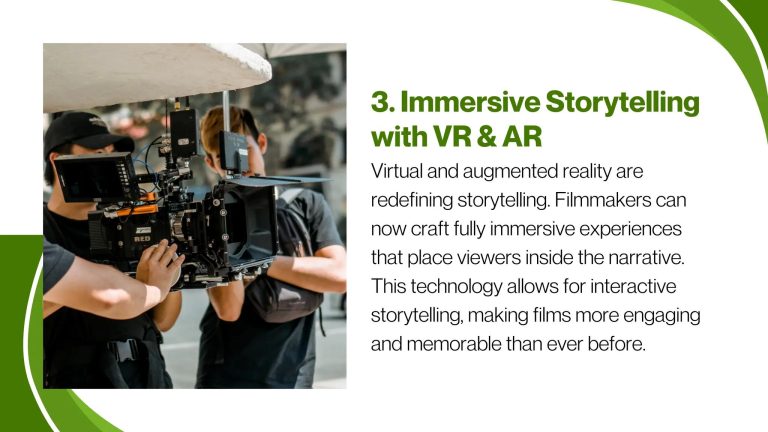A new wave of technology, audience behavior, and industry economics is rewriting how stories are developed, produced, and experienced on screen. From AI-assisted workflows and virtual production to the rise of interactive formats and global writers’ rooms, film and TV storytelling is evolving fast as studios and streamers chase profitability and attention in a crowded market.
As platforms pivot from subscriber growth to sustainable margins, commissioning is becoming more data-driven, seasons shorter, and releases more “eventized,” with weekly drops replacing all-at-once binges. Game adaptations and franchise recalibrations sit alongside a quiet revival of mid-budget genre fare, while AI-enabled dubbing and localization are pushing cross-border hits into the mainstream. Consolidation, post-strike dealmaking, and changing residual models are reshaping creative leverage, even as demand grows for more diverse perspectives and culturally specific narratives. The result is a new storytelling grammar-tighter runtimes, contained worlds, and audience interactivity-that is redefining what succeeds on the big and small screens.
Table of Contents
- Streaming Algorithms Shape Pacing and Micro Genres: Build Season Plans With Mid Episode Hooks and Data Literate Rooms
- AI Assisted Writing Gains Ground: Protect Voice With Strong Style Bibles and Mandatory Human Final Drafts
- Global Viewers Reward Local Detail: Hire Regional Writers and Budget For Authentic Language and Cultural Review
- The Conclusion
Streaming Algorithms Shape Pacing and Micro Genres: Build Season Plans With Mid Episode Hooks and Data Literate Rooms
Studios are retooling writers’ rooms into data-literate hubs, aligning beats with platform metrics that reward completion rate, episode retention, and replayable moments; showrunners describe pacing calibrated to skip-intent spikes, mid-episode re-engagement windows, and micro-genre expectations-cozy thrillers, prestige pulp, snackable sci‑fi-while season plans now map to churn cycles with deliberate mid-episode hooks around the typical drop-off mark and modular scenes designed for trailer and clip ecosystems; executives say the new mandate is to treat each episode as a dynamic funnel, compressing exposition, front-loading character stakes, and seeding serial payoffs that algorithmically surface across taste clusters without diluting tonal identity.
- Hook cadence: Mini-cliffhangers at 10-15 minutes to arrest scroll behavior and lift mid-episode retention.
- Micro-genre tagging: Scenes built to index across niche labels (e.g., “slow-burn heist,” “rom‑com mystery”) for better recommendation fit.
- Beat-level heatmaps: Writers review scene-level exit points to tweak dialogue density and reveal timing.
- Modular set pieces: Self-contained sequences that double as promos, recaps, and autoplay reels.
- Seasonal spine: Arc milestones placed at renewal-sensitive intervals to convert sampling into completion.
- Performance-informed rewrites: Iterations between drops, using early watch-path data to tighten subsequent episodes.
AI Assisted Writing Gains Ground: Protect Voice With Strong Style Bibles and Mandatory Human Final Drafts
Studios and streamers are expanding AI’s role in outlines, beat sheets, and continuity checks, but the industry’s emerging guardrails emphasize authorship and liability: expansive, living style bibles codify voice at the source, while human-signed final drafts preserve creative control, credits, and chain-of-title. Early deployments show that AI accelerates iterations yet drifts without voice discipline, prompting legal and compliance teams to formalize provenance, disclosure, and audit trails-aligned with the WGA’s 2023 MBA limits on compelled AI use and “source material” protections, and with rising transparency expectations under the EU AI Act.
- Style bibles, not prompts: codified tone, cadence, taboo lists, character POV “do/don’t”s, canon facts, and sample pages to anchor outputs.
- Human final draft mandate: credited writers deliver the binding version; AI contributions are treated as research, not authorship.
- Provenance by design: revision history flags AI-assisted passages; access logs and watermarks support audits and dispute resolution.
- Data hygiene: opt-in training corpora, no ingestion of confidential scripts, and sandboxed experimentation to avoid IP spillover.
- Quality assurance: table reads as “red team” checks, sensitivity and continuity passes, and adversarial prompt tests before lock.
- Disclosure norms: producers inform writers when AI-generated material is supplied; credits and compensation remain tied to human work.
Global Viewers Reward Local Detail: Hire Regional Writers and Budget For Authentic Language and Cultural Review
Studios pursuing cross-border growth are reallocating development spend toward region-native storytelling, commissioning local writers’ rooms and formalizing dialect and cultural edit pipelines that catch mistranslations, wardrobe cues, and geography errors before release; platforms report higher completion rates and reduced subtitle drop-off when dialogue preserves idiomatic precision and micro-culture norms-honorifics, food rituals, neighborhood slang-are portrayed with verifiable specificity.
- Hire for place: staff writers with lived experience of the setting; prioritize city and subculture fluency over generic “international” credentials.
- Budget the review: line-item funds for translation QA, back-translation, and cultural continuity passes at script, production design, and picture lock.
- Localize beyond subtitles: vet signage, props, legal clearances, and music cues with regional advisors, not one-size-fits-all consultants.
- Protect dialect: allow code-switching and regional slang; use smart captioning and sound mix to carry context instead of flattening rewrites.
- Measure impact: track completion, rewatch, and share rates in target markets post-authenticity interventions; reallocate spend based on uplift.
The Conclusion
As studios recalibrate around streaming economics, virtual production, and data-informed development, the shape of stories is changing alongside how and where they’re made. Shorter seasons, cross-border co-productions, and interactive formats are moving from experiment to toolkit, even as creators weigh new constraints, from tighter budgets to algorithmic expectations. The result is a marketplace where risk is redistributed: niche audiences wield outsized power, while breakouts can arrive from anywhere.
What happens next will hinge on execution and trust. Tools like generative AI and real-time engines promise speed, but raise questions about credit, rights, and craft. Discovery-amid saturated platforms and shifting windows-remains a hurdle. Regulators are watching, labor deals are evolving, and advertisers are reentering the frame. For now, the through line is clear: the fight for attention is forcing a rethink of narrative form and production practice alike, and the industry’s winners will be those that turn experimentation into repeatable, audience-first storytelling.


